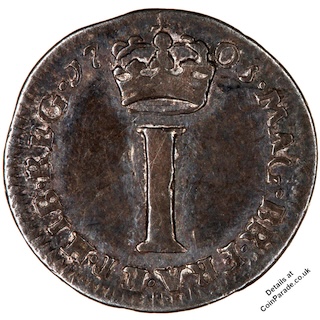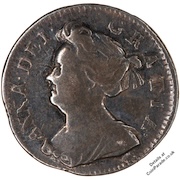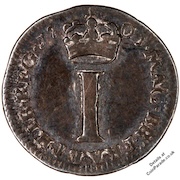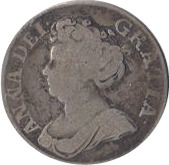
 The 1705 Penny - Anne
The 1705 Penny - AnneSilver Penny of Queen Anne, minted at the Royal Mint in London in 1705. Diameter 12mm, weight 0.54g.
Queen Anne did not issue copper coins, although a pattern for a 1714 copper farthing was produced but not widely circulated as she died that year. The smaller denominations (1p, 2p, 3p and 4p) were silver and have the same design as the Maundy coins, and they were not issued for circulation every year.
The Obverse shows a portrait of Queen Anne facing left, probably by John Croker (1670-1741) who engraved almost all of the dies for the coins of Queen Anne. Legend is "ANNA DEI GRATIA".
The edge is plain.
 The Reverse shows a crowned Roman numeral 'I'. Legend is "MAG BR FR ET HIB REX 1705" with date divided around top.
The Reverse shows a crowned Roman numeral 'I'. Legend is "MAG BR FR ET HIB REX 1705" with date divided around top.Image credit: Museums Victoria
Mintage: Not known
Minted at The Royal Mint
SCBC: 3598
More information (monarch, year, mint, country, category) can be found below coin listings.
Below are some coins currently being offered on eBay. As an eBay Partner, We may be compensated if you make a purchase.
List items on:
List items on:
Anne (1702-1714)
 Anne became Queen of England, Scotland and Ireland on 8 March 1702. On 1 May 1707, under the Acts of Union, two of her realms, the kingdoms of England and Scotland, united as a single sovereign state known as Great Britain. Some of these post-Union coins have an 'E' below the bust for Edinbugh Mint.
Anne became Queen of England, Scotland and Ireland on 8 March 1702. On 1 May 1707, under the Acts of Union, two of her realms, the kingdoms of England and Scotland, united as a single sovereign state known as Great Britain. Some of these post-Union coins have an 'E' below the bust for Edinbugh Mint.Born Anne Stuart, the daughter of James II, she became Queen after the death of William III. Anne was the last of the Stuarts and became the first monarch of the newly formed United Kingdom of Great Britain.
Some coins have "VIGO" on them, meaning they were minted from bullion captured from the Spanish fleet at Vigo Bay. They can be quite rare and expensive.
The regnal years for Queen Anne coins were:
1703:SECVNDO; 1705:QVARTO; 1706:QVINTO; 1709:OCTAVO; 1711:DECIMO; 1713:DVODECIMO; 1714:DECIMO TERTIO.
Category: Penny
The Penny is one of the most famous British coins. The coin itself has been around since 600AD and at various times has been struck in silver, copper and bronze. Originally split into halfpennies and farthing, it is now itself the least denomination coin currently in circulation. Made from copper (actually copper plated steel). Originally there were 12 pennies in one shilling and 240 pennies in £1; since decimalisation in 1971 there are 100 new pence in one pound.
Composition: Early pennies were Silver, then Copper, Bronze and Copper coated steel.
Collection: Maundy Money
Maundy Money are coins traditionally given out by the Monarch as a gift to the poor at Royal Maundy. The ceremony, which is associated with Christianity, is held on Maundy Thursday which is the day before Good Friday. The Maundy set consists of four coins, denominated one penny, two pence, three pence and four pence. The number of sets given out to each man and woman is equivalent to the age of the Monarch in years.
Which Mint: The Royal Mint
The Royal Mint is the designated place for the UK to mint coins. It dates back well over 1000 years and is a Government-owned company. Formed in the reign of Alfred the Great about the year 886, during the period 1279-1812 it was generally referred to as The Tower Mint as it was housed at the Tower of London. The Master of The Royal Mint has included famous figures such as Sir Isaac Newton.
Since 2010 it has operated as Royal Mint Ltd, a company owned by HM Treasury, under an exclusive contract to supply all coinage for the UK although it also produces medals and coins for other countries. It is currently located at Llantrisant, Wales.
Country of Origin: United Kingdom
The United Kingdom (UK) is the Union of England, Scotland, Wales and Northern Ireland. It is often refered to as Great Britain (GBR). It has a long, rich history. The orignal coinage was Pounds, Shillings and Pence but since decimalisation on 15 February 1971, it is £1 = 100p, that is One Pound = 100 pence. The coinage of the UK is also a long history, the Royal Mint being established as long ago as 886AD when coins were hammered. Today there is perhaps 30 billion coins in circulation, and many (numismatic) collectors coins and sets are issued frequently in gold, silver and other metals.








